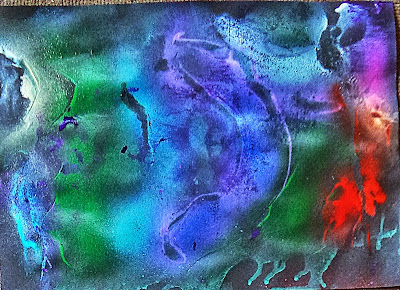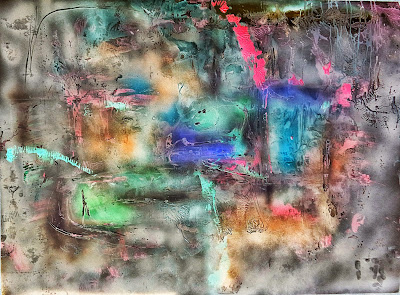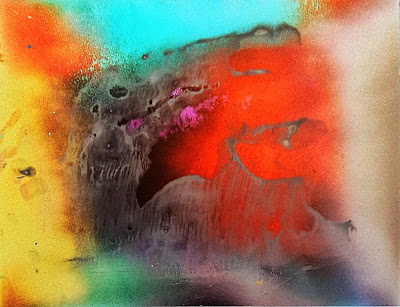Saturday, 28 March 2015
philosophy of art, science ,. etc continued....
Philosophy of art, science, etc
There is no such thing or scientific subject such as
'philosophy of art, science, music, etc" in the narrow or strict sense.
Activities that are labelled as such are reflections on or thinking and talking ABOUT
(second order activities compared to the first order activities of DOING art, music,
science, and other) socio-cultural practices.
Philosophy (as love of wisdom) provides insights into and understanding of anything
and by means of such insights and understanding one MIGHT arrive at wisdom. Such
'philosophical' thinking about/reflecting on and talking about first order activities
and practices may or may not assist in 'wisdom'.
The discourse and socio-cultural practice of Philosophy, have like all discourses
and socio-cultural practices restrictions, norms, aims and a purpose. People often
stray from these and do things that are unrelated to the discourse of philosophy.
The cross the boundaries of this discourse and attempt to make philosophy do what
it is not able to do. They end up doing things in the name of philosophy that are
meaningless when they employ language in ways that no longer make sense. Whatever
it is they are doing, whatever name they call it, is not philosophy in the strict
sense. It might be philosophy in the wider sense as when it is said "everyone has
a philosophy", in other words an opinion.
ulrich 28/3/2015
Philosophy of art, science, etc
Philosophy of art, science, etc
There is no such thing or scientific subject such as
'philosophy of art, science, music, etc" in the narrow or strict sense.
Activities that are labelled as such are reflections on or thinking and talking ABOUT
(second order activities compared to the first order activities of DOING art, music,
science, and other) socio-cultural practices.
Philosophy (as love of wisdom) provides insights into and understanding of anything
and by means of such insights and understanding one MIGHT arrive at wisdom. Such
'philosophical' thinking about/reflecting on and talking about first order activities
and practices may or may not assist in 'wisdom'.
ulrich 28/3/2015
Sunday, 22 March 2015
Technique and the application of a substance such as paint
Technique and the application of 'paint'.
The unique technique/s (or method/s) of the painter consists of the numerous special skills s/he has developed.
One aspect of technique (or range of techniques) of a painter is the way in which he produces colours on the
support. This could be the application of (different types of) paint, light, tiles, wax, oil, plaster, etc by
means of brushes, knives, pencils, reeds, computers, printers, etc to spray, drip, throw, sewn, etc to produce
colours or shades of grey (situated anywhere on the continuum from white to black). In other words, the aim of
employing these and other tools is to transfer colours (or the lack of colour) to the support.
In many cases a work will be defined by the manner in which 'paint' (etc) is transferred and applied to the
support. In some cases the manner in which and the tools by means of which 'paint' (etc) is transferred and
applied to the support make no difference - the only thing that matters is: the production of colours (or the
lack of them) on the support.
In many cases the main function of colours is to create a certain form (or the absence of clearly distinguishable
forms). Another function of colour is the fact that different colours (their tones, degree of saturation and
combinations of colours and their tones) have different strengths\s and functions. Colours express or represent
certain psychological 'moods', feelings and emotions, they stimulate the human (and animal) brains in different
ways and they convey different messages. These effects of colour is most likely further differentiated by factors
such as culture, subculture, socio-economic class, age, historical period, the context in which they are used, etc.
This context refers among other things to the institution (for example a disco, dance, school, uniuversity, church,
mosque, funeral, wedding, etc) in which the colours are used. Combinations of different colours, their degree of
saturation and tones will also produce a certain message and modify the strength and other aspects of a message.
The way in which paint or another substance is transferred to the support may in some cases be of primary importance
while in other cases it might be irrelevant. In some cases producing a certain colour (tone, degree of saturation,
etc) may be the aim of the artist and the way in which it is produced might be secondary or irrelevant.
22 March 2015 Ulrich
Monday, 9 March 2015
Atelier UlrichdB: Directories of Art Galleries
Atelier UlrichdB: Directories of Art Galleries: Directories of Art Galleries DIRECTORIES of ART Galleries – the first 2 are the best (only my opinion) http://www.globalgalleryguide.com/ ...
Directories of Art Galleries
Directories of Art Galleries
DIRECTORIES of ART Galleries – the first 2 are the best (only my opinion)
http://www.globalgalleryguide.com/
http://www.the-art-world.com/art-galleries.htm
http://theartling.com/galleries/
http://www.saatchigallery.com/london_gallery_guide.htm
http://www.re-title.com/
http://zeroland.co.nz/directory/visual-arts/art-museums-and-collections/
http://www.refseek.com/directory/art.html
http://www.degruyter.com/view/product/186399
http://www.berlinartlink.com/resources/berlin-gallery-directory/
http://www.info.com/art%20galleries%20directory?cb=3&cmp=3804
http://fineartamerica.com/gallerydirectory.html
Atelier UlrichdB: a slice from the process of painting - under the m...
Atelier UlrichdB: a slice from the process of painting - under the m...: A slice from the process of painting. A few words on some aspects of one vertical slice of the process of creating a work of visual art, mo...
a slice from the process of painting - under the microscope
A slice from the process of painting.
A few words on some aspects of one vertical slice of the process of creating a work of visual art, more specifically by painting.
These words are only concerned with one minute aspect of this multi-dimensional, many-levelled and complex activity and there are,
obviously, many other dimensions, levels and aspects involved, for example the history of aesthetic (artistic and painterly) ideas,
techniques employed in painting, formal structures (such as forms, colours, composition, textures, etc), the art business (such
as the art market, commercial galleries, collectors, etc), critique and review of art, art/artists and the media, different kinds
of expectations , influences and assumptions various groups (informed viewers, the general public, other professional and
serious artists, Sunday or hobby'painters', academic artists, academics and teaching staff, educational institutions, etc)
connected to art have of and on visual art, etc.
It is clear from this that the process of painting is merely one grain of sand on a vast beach in the universe of socio-cultural
practices and more specifically the discourse of visual arts and the genre of painting, and the Western tradition of this genre.
In general serious artists critically engage with their external and internal worlds, frames of reference and mind sets employed
for interacting with, relating to, perceiving, interpreting, understanding, dealing with, reacting and responding to and existing
in and as part of their (and others') life worlds.
This existence and the critical, questioning, explorative manner of doing this or 'being' this existence consist of a diversity of
cultural, social, psychological, physical, etc processes. The execution of the process of painting involves aspects from many of
these and other factors and depends on and employs them both intentionally and explicitly as well unintentionally and implicitly.
The artists may or may not be aware of these processes and factors, but, in spite of the fact that these things are explicit or
implicit, there are certain things that inevitably will be involved in the process of painting.
Some of these things are pre-conceptual and for not yet conceptual, while others are more conceptual and some are already
conceptualized. Other things that form part of the pre-conceptual (and/or not yet conceptualized) aspects of the painting process
are, sub-conscious and pre-rational and/or not yet, fully, rational. The serious, creative artist employs (or 'is' or function as)
a certain type of 'consciousness', awareness and intelligence. This creative intelligence can be compared to the intelligence of
an excellent or genius footballer (rugby player, swimmer and other types of sportsmen). Although there are obviously many things
that are different in the case of other types of socio-cultural practices creative people execute, employ and 'are' (for example
composers, musicians, dancers, actors, creative thinking scientists, mathematicians, architects, designers, etc), there are many
similarities as well.
The norms of these, and other discourses in terms of which these creative individuals work determine things such as the available
and in/appropriate skills, long term goals, immediate aims, purposes, material, ideas, questions, ways of questioning , dealing
with ideas and dissolving problems (or problematization). The creative artist deals with many of these things in a pre-conceptual
and sub-conscious (and even 'rational') manner and with others in a more conscious and conceptual (and rational) manner.
One aspect of the latter consists of a second-order, meta or reflective activity on the process of painting. Certain artists, for
example Paul Klee, found it necessary and even essential to reflect on and dealing critically with the and their own process of
painting, while others may found it less important and some might find this 'philosophical' activity irrelevant and not at all
important. The points I wish to make in this article is to show that the, seemingly very concrete and practical, process of
painting 1) have both i) a concrete, practical aspect (with its host of related skills, activities, etc) as well as ii) a 'mental'
side (consisting of other, although related, skills, activities, know-how, information, understanding, grasp, intelligence, etc).
2) And, that accompanied by, no underlying and consisting of, both the 'more' practical (and visible?) or concrete and the 'more'
mental (invisible?) 'stages' or (intertwined) 'aspects' of the process of painting involve 'activities, processes and structures'
that are situated on a continuum that has as a) one pole things that are, as yet, completely sub-conscious, not conceptualized
(but that could be made or become conscious and conceptualized) and b) as the other pole, things that are totally conscious and
conceptualized.
So-called 'contemporary' painting (say, for example from the 1950's onwards), increasingly, is concerned with
(to the point of making it its subject-matter and contents, as well as its main purpose, aim and objective) -
the identification of, dealing with, exploration, analysis anddepiction of both the sub-consciousness and
conscious aspects of the process of creating and more specifically the creating process of painting (although
this is also true, or rather, meaningful, in the case of other arts, such as dance, film, video, composing of
classical music, playing of classical instruments, writing, humanities and the sciences).
Sunday, 8 March 2015
what do you expect from an online gallery to sell your work?
Annonce de Bientôt : Un nouveau réseau pour vendre vos oeuvres
Hervé Gicquel Serial entrepreneur, Business Angel Top Contributor
Qu’attendez-vous d’un nouveau réseau 2.0 pour présenter et vendre vos œuvres ? (philosophie, fonctionnalités, curation, aides, conseils, expos physiques…).
———————–
ulrich de balbian
ulrich de balbian
Scientific writer and philosopher
* high quality, carefully selected paintings and/or artists
* to be clear about the genre or type (for example figurative, non-objective, etc) o type modern, contemporary, new styles) of work
* to have a base of serious buyers
* visibility to media and both on and outside internet
* Peintures et / ou artistes de haute qualité, soigneusement sélectionnés
* d’être clair sur le genre ou le type (par exemple figuratif, non objective, etc) et la période (moderne, contemporain, de nouveaux styles) de travail
* d’avoir une base d’acheteurs sérieux
* la visibilité aux médias et à la fois sur et en dehors internet
Pinturas y / o artistas 1) de alta calidad, cuidadosamente seleccionados
* tener claro el género o tipo (por ejemplo figurativo, no objetiva, etc) y el período (moderno, contemporáneo, nuevos estilos) de trabajo
* tener una base de compradores serios
* la visibilidad a los medios y tanto dentro como fuera de internet
* di alta qualità, pitture e / o artisti selezionati con cura
* per essere chiari sul genere o tipo (ad esempio figurativa, non oggettiva, ecc) e il periodo (moderna, contemporanea, nuovi stili) del lavoro
* avere una base di gravi acquirenti
* visibilità a media e sia all’esterno internet
* hohe Qualität, sorgfältig ausgewählten Gemälden und / oder Künstler
* Löschen über das Genre oder die Art zu sein (zum Beispiel figurativ, nicht objektive, etc.) und die Zeit (modern, zeitgenössisch, neue Stile) der Arbeit
* um eine Basis für ernsthafte Käufer haben
* Sichtbarkeit für Medien und sowohl auf als auch außerhalb von Internet-
* высокое качество, тщательно отобранные картины и / или исполнителей
* иметь четкое представление о жанре или типа (например, образного, необъективные и т.д.), и срок (современный, современный, новые стили) работы
* иметь базу серьезных покупателей
* видимость в средствах массовой информации и, как на и вне Интернет
http://www.newstylesgallery.info and Facebook
Subscribe to:
Posts (Atom)
































